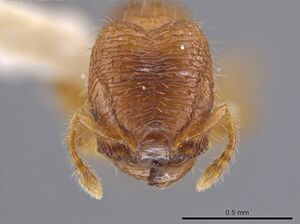Pheidole dorsata
| Pheidole dorsata | |
|---|---|

| |
| Scientific classification | |
| Kingdom: | Animalia |
| Phylum: | Arthropoda |
| Class: | Insecta |
| Order: | Hymenoptera |
| Family: | Formicidae |
| Subfamily: | Myrmicinae |
| Tribe: | Attini |
| Genus: | Pheidole |
| Species: | P. dorsata |
| Binomial name | |
| Pheidole dorsata Wilson, 2003 | |
The type colony was found in a shaded coffee plantation. (Wilson 2003)
Identification
See the description in the nomenclature section.
Keys including this Species
Distribution
Known from Columbia and Guyana.
Latitudinal Distribution Pattern
Latitudinal Range: 10.991976° to 10.315406°.
| North Temperate |
North Subtropical |
Tropical | South Subtropical |
South Temperate |
- Source: AntMaps
Distribution based on Regional Taxon Lists
Neotropical Region: Colombia (type locality), Guyana.
Distribution based on AntMaps
Distribution based on AntWeb specimens
Check data from AntWeb
Countries Occupied
| Number of countries occupied by this species based on AntWiki Regional Taxon Lists. In general, fewer countries occupied indicates a narrower range, while more countries indicates a more widespread species. |

|
Estimated Abundance
| Relative abundance based on number of AntMaps records per species (this species within the purple bar). Fewer records (to the left) indicates a less abundant/encountered species while more records (to the right) indicates more abundant/encountered species. |

|
Biology
Castes
Images from AntWeb
   
| |
| Worker (major/soldier). Specimen code casent0636782. Photographer D. Wickwar, uploaded by University of Utah. | Owned by JTLC. |
Nomenclature
The following information is derived from Barry Bolton's Online Catalogue of the Ants of the World.
- dorsata. Pheidole dorsata Wilson, 2003: 635, figs. (s.w.) COLOMBIA.
Unless otherwise noted the text for the remainder of this section is reported from the publication that includes the original description.
Description
DIAGNOSIS A member of the tachigaliae group, characterized by 11-segmented antennae, and distinguished within it as follows.
Major: in side view, pronotal profile broken by a sharp obtuse angle; rugoreticula present mesad and laterad to eye; all of dorsum of head posterior to eye transversely carinulate except for antennal scrobes, which are smooth;humeri and anterior pronotal margin rugoreticulate; postpetiole from above very broad and narrowly elliptical in shape.
Minor: space between eyes and antennal fossae carinulate, foveolate, and opaque; rest of head smooth and shiny; in full-face view, a single, very long curving hair extends from each occipital corner; eye oval and set well forward on the head.
MEASUREMENTS (mm) Holotype major: HW 0.68, HL 0.74, SL 0.30, EL 0.08, PW 0.44. Paratype minor: HW 0.36, HL 0.40, SL 0.28, EL 0.06, PW 0.26.
COLOR Major: body light brown, appendages yellowish brown.
Minor: body medium brown, appendages brownish yellow.
Figure. Upper: holotype, major. Lower: paratype, minor. Scale bars = 1 mm.
Type Material
COLOMBIA: Finca El Recreo, Magdalena, 850 m, col. Charles Kugler. Museum of Comparative Zoology
Etymology
L dorsata, of a ridge or back of a hill, referring to the peaked pronotum of the major in side view.
References
- Wilson, E. O. 2003. Pheidole in the New World: A dominant, hyperdiverse ant genus. Harvard University Press, Cambridge, MA. (page 635, fig. major, minor described)
References based on Global Ant Biodiversity Informatics
- Wilson E. O. 2003. Pheidole in the New World: A Dominant, Hyperdiverse Genus. Harvard University Press


